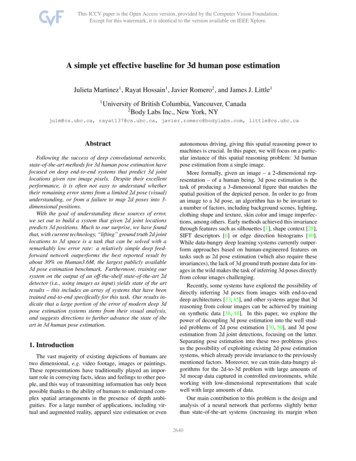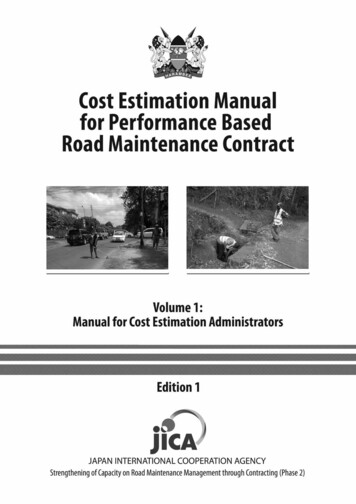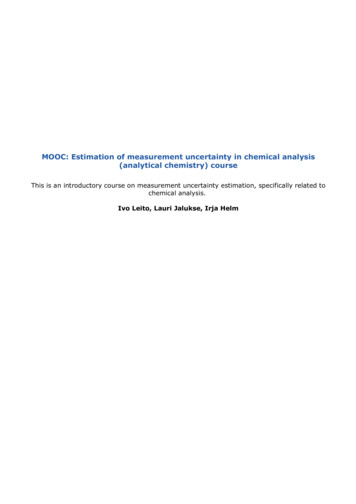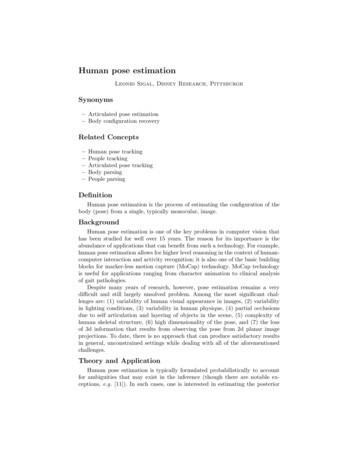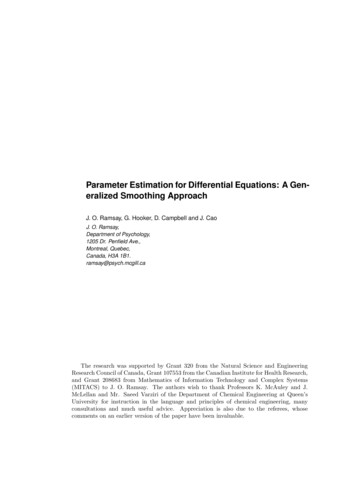
Transcription
XPPE: Cross-Platform Performance Estimation of HardwareAccelerators Using Machine LearningHosein Mohammadi Makrani, Hossein Sayadi, Tinoosh Mohsenin,Setareh rafatirad, Avesta Sasan, Houman HomayounGeorge Mason UniversityFairfax, VA omyou}@gmu.eduABSTRACTThe increasing heterogeneity in the applications to be processedceased ASICs to exist as the most efficient processing platform.Hybrid processing platforms such as CPU FPGA are emerging aspowerful processing platforms to support an efficient processingfor a diverse range of applications. Hardware/Software co-designenabled designers to take advantage of these new hybrid platformssuch as Zynq. However, dividing an application into two parts thatone part runs on CPU and the other part is converted to a hardwareaccelerator implemented on FPGA, is making the platform selection difficult for the developers as there is a significant variationin the application’s performance achieved on different platforms.Developers are required to fully implement the design on eachplatform to have an estimation of the performance. This process istedious when the number of available platforms is large. To addresssuch challenge, in this work we propose XPPE, a neural networkbased cross-platform performance estimation. XPPE utilizes theresource utilization of an application on a specific FPGA to estimate the performance on other FPGAs. The proposed estimation isperformed for a wide range of applications and evaluated against avast set of platforms. Moreover, XPPE enables developers to explorethe design space without requiring to fully implement and mapthe application. Our evaluation results show that the correlationbetween the estimated speed up using XPPE and actual speedup ofapplications on a Hybrid platform over an ARM processor is morethan 0.98.CCS CONCEPTS Computer systems organization Reconfigurable computing;KEYWORDSDesign space exploration, performance estimation, machine learning, acceleratorPermission to make digital or hard copies of all or part of this work for personal orclassroom use is granted without fee provided that copies are not made or distributedfor profit or commercial advantage and that copies bear this notice and the full citationon the first page. Copyrights for components of this work owned by others than ACMmust be honored. Abstracting with credit is permitted. To copy otherwise, or republish,to post on servers or to redistribute to lists, requires prior specific permission and/or afee. Request permissions from permissions@acm.org.ASPDAC ’19, January 21–24, 2019, Tokyo, Japan 2019 Association for Computing Machinery.ACM ISBN 978-1-4503-6007-4/19/01. . . 15.00https://doi.org/10.1145/3287624.3288756ACM Reference Format:Hosein Mohammadi Makrani, Hossein Sayadi, Tinoosh Mohsenin,, Setarehrafatirad, Avesta Sasan, Houman Homayoun. 2019. XPPE: Cross-PlatformPerformance Estimation of Hardware Accelerators Using Machine Learning.In 24th Asia and South Pacific Design Automation Conference (ASPDAC ’19),January 21–24, 2019, Tokyo, Japan. ACM, New York, NY, USA, 6 ODUCTIONThe end of Dennard Scaling era and the thrive to achieve high performance led to evolution of new computer architecture designs[10].ASICs persist to be no more the best executing hardware platformdue to the design complexity, involved costs and the time-to-marketchallenges [1, 19].New hybrid platforms such as CPU FPGA systems are emergingas the potential solution, despite the fact that FPGAs are nearly oneorder magnitude slower than the specialized ASICs [9]. FPGAs enjoy other benefits such as on-the-fly programmability, reconfigurability, energy-efficiency, and the development of hardware/softwareco-design platforms[2, 18]. This also facilitates engineers to performhardware design without requiring deeper insights into hardwaredesign [7].As there exists a performance gap among the implementation ofan application on various FPGA devices (1 -1000 ), it is importantfor the developers to determine which of the FPGA platforms tochoose. This challenge is further complicated with the availabilityof a large number of FPGA boards. To yield the high-performanceby running appropriate applications on FPGAs, it is importantto perform the design space exploration (DSE) [7] using timinganalysis provided by CAD tools. After that, the designer can decideto implement an application on the suitable platform.There are challenges associated with the static timing analysisof digital systems designs [4]: The latest version of CAD toolsprovided by Xilinx (Vivado), does not have the capability to reportthe maximum frequency achievable for the corresponding code.The user must request a target frequency, and the tool reports eithera "pass" or "fail" for its attempt to achieve this goal [5]. While thereare 25 optimization strategies predefined in the tool, applying themsequentially, is extremely tedious and time consuming. Therefore,the estimation of the achievable performance improvements willaid the designer to choose faster and wisely among different FPGAdevices.The performance estimation for choosing the platform to run theapplication faces the challenges from the vast heterogeneity of existing type of applications and the FPGA devices. Most of the existingworks predict performance based on the application characteristics
ASPDAC ’19, January 21–24, 2019, Tokyo, Japanand depending on the resource consumed [7–9, 16], but limited tospecific FPGAs. Moreover, these works lack a detailed comparisonof achieved performance benefits to the processor subsystems.In this work, we classify FPGAs into three categories: low-end,medium, and high-end FPGAs based on the available resources onthe FPGA. Furthermore, it has been shown that the performanceof an application can be enhanced by varying the parameters ofFPGA such as frequency, memory bandwidth [11, 13], and so on[27]. As such, we explore the impact of different parameters andthe class of the FPGA on the performance of an application.Based on the resource utilization of an application across different FPGA’s classes and the achieved performance (speedup),we build a machine learning based cross platform performanceestimation (XPPE) tool. XPPE uses the resource utilization of anapplication reporeted by Xilinx HLS tool and predicts the sped upof that applications on different platforms. Our evaluation showsthe predicted speed up and the actual speedup over ARM CortexA-9 MPCore processor for different wide range of applications hasa correlation of R 0.98.The main contributions of this work are: Design space exploration of different classes of FPGAs anddetermine the parameters that have significant impact onthe performance w.r.t the type of application. Provide a cross-platform performance estimation tool (XPPE)based on the machine learning model to determine the performance improvement (acceleration) over a general purposeprocessor (ARM Cortex A-9 MPcore in our experiments).2EXPERIMENTAL SETUPThe experimental setup for building a machine learning model,and the methodology to determine the important parameters ofFPGAs for performance boosting is presented in this section. Wefirst require a dataset for training the model. Hence, we present ourbenchmarks, FPGA devices, and the methodology of performingour experiments to collect the required data.2.1Studied applicationsIn order to model the performance of applications, a dataset wasgenerated from popular HLS benchmark suits to make sure thatthe diversity of benchmarks is comprehensive. The selected benchmarks are from Machsuit [17], S2CBench [23], CHStone [6], Rosetta[29]. To increase the diversity and the size of dataset, we also useda collection of 10 different image processing kernels from XilinxxfOpenCV. We totally covered 70 benchmarks which include a widerange of domains from simple kernels to machine learning and realtime video processing that they reflect the latest application trends.Each application was implemented and verified for functionalcorrectness before analyzing across different FPGAs studied.As a basis for comparison, all applications were run in a singlethreaded manner on an ARM A9 processor with a 650 MHz CPUclock. The functions used for the software baseline were standardfunctions that were not optimized for FPGA. The software utilizedfor testing was the Xilinx SDSoC development suite, which usesVivado and Vivado HLS version 2017.2. as its underlying software.H.M. Makrani et al.Table 1: FGPA devices’ specificationFamilyZynqArtix-7Zynq Ultrascale Virtex-7Ultrascale Zynq Ultrascale UltraScaleUltrascale UltraScaleUltrascale UltraScaleUltrascale -endHardware platformsFor selecting FPGA devices, we targeted three different class ofFPGAs such as Low-end, Medium-end, and High-end. We selectedall of our devices from Xilin. 20 different FPGA technologies weretested to generate the dataset. Table 1 shows the FPGAs and theirclasses. Devices from three main Xilinx families were chosen: Zynq,Artix, and Virtex. Additionally, from the Zynq and Virtex family,devices from among the 28nm, 20nm (UltraSCALE), and 16nm(UltraSCALE ) were used. The FPGA devices are chosen based ona wide array of available resources and technologies across thespectrum of each family.2.3Performance measurementWe kept the hardware/software co-design relatively simple, withonly the data transceiver and hardware accelerator located in thePL part. The source and destination data was transferred directly tothe accelerator via an AXI-4 data bus. This method of data transportis considered directly into our timing model of hardware performance as well as into the device utilization. Other parameters tothe accelerator functions (such as filter size specifications, tuningparameters, etc.) were implemented as standard data ports to theaccelerator.To measure the performance, each application was synthesized inHLS for its respective device. Timing information for the estimatedhardware performance was gathered using the reported clock-cyclecount of the maximum latency of the accelerator and plus datatransceiver. In order to estimate the amount of time that was spentin hardware and software for the co-design of each application,applications are first evaluated on fully implementable SoCs fromthe Zynq family (Steps 4-5 in Figure 1). A performance analysis wasexecuted on each application to determine the overall executiontime of the full design. This is used for estimating the total executiontime. Tough the tool provided a worst-case estimation, it provided atrend that could be used for total execution time. (It should be noted,however, the performance estimation by the tool had a tendency to
XPPE: Cross-Platform Performance Estimation of HardwareAccelerators Using Machine LearningC Applicationcode1Accelerator code: HWspecific optimizationand pragmas2Synthesize with HLSEstimate performanceof full C applicationImplement on boardand analyzeperformance345ASPDAC ’19, January 21–24, 2019, Tokyo, JapanTable 3: Description of featuresCategoryBrief DescriptionRequested clock period, estimatedclock period by HLS, UncertaintyUtilization and availability ofLUT, FF, DSP, and BRAMPerformanceFigure 1: Experimental FPGA design flow for obtaining performanceTable 2: Average speed up of applications on 3 different FPGAs over Arm processorApplicationTypeMachine LearningImage/Video 212.7428.43Low-End(XC7Z010)5.519.263.196.78be more than 1.5-1.75 the execution time of an application testedon a fully implemented design.)A ratio of the time spent in Programmable Logic (PL) vs ProcessorSystem (PS) was then calculated using the synthesis reports fromHLS and the overall performance estimations. The calculated ratiosfor different Zynq boards varied only by about 1-2%, so these ratioscould be used with decent confidence for the remainder of thetechnologies tested. These ratios were then applied to the hardwareexecution times for the FPGA technologies that were not availableas SoC platforms. Table 2 presents achieved acceleration comparedto ARM A9 processor for different types of applications on threeFPGA devices. This table is important as it shows interesting trendsthat we will discuss it in section 4.2.4Data collectionTo build a dataset, we first require to extract all possible featuresthat we can get from HLS reports. HLS related features consist theinputs of our machine learning model. Table 3 shows the featuresthat we can extract from HLS reports. As it is not wise to determinethe importance of each feature in advance, we extract as manyrelevant features as possible (total 183 features). We do not use principal component analysis to reduce the dimensionality of features.Because if there is a correlation between an additional feature andthe target variable, the model can learn it. If there is no correlation,the model learns to ignore. Therefore, more features are at least asgood as a model with only a subset of the same features. However,too many features may lead to the over-fitting problem. Hence,we address this issue later in this paper. Moreover, the machinelearning model will be trained to estimates performance speedup of application if implemented on various FPGA devices. Forcross-validation of the accuracy of the machine learning modeland according to the accepted practice in data analytics, we set thetesting size a quarter of the size of the dataset.3XPPEWe introduce XPPE (cross-platform performance estimator), anautomated performance prediction tool to estimate the speedupof an application when implemented as a hardware accelerator onFPGA devices. The estimation is based on the resource utilizationreport by HLS Vivado tool, available resources on target FPGA,ResourcesLogic andarithmetic operationMemoryMultiplexerNumber of features336Bitwidth/resource statistics of operations132Number of memory words/banks/bits;Multiplexer input size/bitwidth84and application’s characteristics. The promising part of XPPE isthat it is enabled to estimate the speed up of accelerator on anyother FPGA devices when the resource information of that FPGA isavailable. We anticipate p rogrammers will use this tool in the HLSdevelopment process. Note that our tool does not predict how toport a code to FPGA, but how much speedup is achievable if portedonto different FPGA devices.Overview: Figure 2 illustrates the overview of the tool. XPPEis written in MATLAB and uses a neural network to estimate thespeedup of an application for a target FPGA over ARM processor.XPPE gets HLS report as an input and extracts the information ofthe FPGA used for synthesize, and the resource utilization on thatFPGA. Moreover, the user must provide the specification of a targetFPGA. There is no limit on the specification of the target FPGA.Therefore, XPPE can be used for future FPGA devices and gives aninsight to designers.Artificial Neural Networks (ANNs) are a class of machine learning models that can map a set of input parameters to a set of targetvalues. The model used in this tool is a 3-layer fully connectedneural network with 900 hidden neurons. The inputs are availableresources on target FPGA, resource utilization of application reported by HLS (extracted features as in Table 3), and characteristicsof the application for cross-platform speedup estimation. The output is the speedup estimation for on the target FPGA over ARMA-9 processor.FeaturesF1F2KernelsF3F4Speedup over ationof targetFPGA deviceXPPEEstimatedSpeedup fortarget FPGAdeviceFigure 2: Overall flow of XPPETraining and validation: MATLAB’s Neural Net Fitting toolhas been used for building the model. We trained the network withLevenberg-Marquardt algorithm. Figure 3 shows the correlation ofoutput of network and the target value for different datasets namely,train, validate and the test data. The obtained correlation betweenthe estimated and actual speedup for the test data is R 0.97. Figure4 shows the histogram of error.
ASPDAC ’19, January 21–24, 2019, Tokyo, JapanValidation: R 0.9984DataFitY T1000800600400200120070DataFitY T1000Relative RMSE (%)Output 0.99*Target 22Output 0.97*Target 9.3Training: R 0.9862914001200H.M. Makrani et al.8006004002005001000200400TargetOutput 0.98*Target 4.8Output 1*Target -70DataFitY T100080060040020000500800 1000 1200All: R 0.98513Test: R 0.978331200600Target14001000120040302010100 200 300 400 500 600 700 800 9001k1.1k 1.2k 1.3k#Neurons1000800600400200005001000TargetTo evaluate the accuracy of the estimator, we use equation (1) tocalculate the percentage RMSE (Root Mean Squared Error) betweenthe predictions and the real measurements.N1 Õ pi a i 2() 100N n 1 ai(1)where N is the number of samples, and pi and ai are the predicted and actual values of the sample, respectively. We want the %relative RMSE to be as low as possible. RMSE is a standard metric inregression which is sensitive to scalability. For example, an RMSEof 1 s in runtime prediction is not acceptable if the actual runtime is2 s, but can be acceptable if the actual runtime is 1000 s. Expressingthe error as a percentage of the actual value solves this issue. Theproposed neural network architecture has an mean square error of5.1%. The model has an accuracy of 91%, 98%, and 95% for training,validation and testing respectively.Assessment of Neural Network: Figure 4 shows how the number of hidden neurons changes the average accuracy of speed upestimation. Based on the results, we decided to fix the numberhidden neurons to 900 for XPPE where the prediction accuracy isnearly 94.9% on Average.450DataFitY TFigure 3: Neural network performanceRelativeRMSE 60Figure 4: Error of neural network1400TargetvutImg/Vid Proc.Machine Learning000MathematicalCryptographyDESIGN SPACE EXPLORATIONThe goal of High-Level Synthesis design is to reduce the complexityof developing hardware accelerator and to increase the usage ofreconfigurable devices in different domains. HLS helps a softwaredeveloper to convert the high level code into hardware languagewithout having deep knowledge of hardware. But, there exists adecision making gap between a hardware design and its implementation on FPGA device. As various FPGA devices provide differentcapability and as a result different speedup. As software developersmay don’t have enough knowledge about choosing the best devicefor their implementation, it is a crucial step to first perform a designspace exploration.In this section, we show how XPPE can be used to explore thedesign space of hardware acceleration. To this goal, we first useXPPE to estimate the speedup of different applications on varioustypes of FPGAs. In order to shed insight on the raw results, weanalyze the importance of FPGA parameters on the accelerationspeedup of applications.In order to determine the importance of FPGAs’ parameters, weemployed linear regression on our date gathered from XPPE toextract the relation between different FPGA parameters and thespeedup of applications. The coefficient of each FPGA parameterdetermines the impact of that parameter on the speedup (performance) of the accelerator. The FPGA parameters selected to buildthe relation for speedup are FPGA frequency, the number of logiccells, look-up-tables (LUTs), flip-flops (FF), Block RAMs (BRAMs),DSPs, and bandwidth of the interconnect between FPGA and DRAM.Figure 5 illustrates the visualization of coefficients. The observation reveals that different parameters of FPGA, depending on theapplication type, plays a crucial role in improving the accelerator’sspeed up.To correctly interpret the results, we have to first understand thecharacteristics of each application. In our experiments, we observedthat applications can be data-intensive, have multistage computation, or could be highly parallel. We consider an application asdata-intensive if it several times transfers a large amount of datafrom DRAM to PL part through DMAs (direct memory access) orvice versa. Moreover, we refer to dependent kernels of an application that cannot work in parallel as multistage computation. Toaccelerate these part of an application, pipeline strategy or highlevel parallelism such as multiple instances of such kernels can beused. On the other hand, some kernels in an application can beimplemented in a fully parallel manner and we can unroll thosecompute units to increase the throughput at the cost of LUTs/FFs.these kernels are called highly parallel kernels. We note that different HLS optimizations employed based on the target FPGA size.The aforementioned characteristics directly impact on the resource requirements of an application. Therefore, the effectiveness
Normalized CoefficientsXPPE: Cross-Platform Performance Estimation of HardwareAccelerators Using Machine LearningASPDAC ’19, January 21–24, 2019, Tokyo, Japan10.90.80.70.60.50.40.30.20.10Machine LearningFPGA FrequencyImage/Video ProcessingLogicCell/LUT/FFCryptographyMemory BlocksDSPMathematicalDRAM BandwidthFigure 5: Parameter importance based on regressionof FPGAs’ parameters on the performance improvement of acceleration depends on these characteristics in the applications. Weidentified these characteristics in each class of application and Table4 illustrates them.Table 4: Characteristics of applicationsApplicationTypeMachine LearningImage/Video ProcessingCryptographyMathematicalDataIntensive MultistageComputation HighlyParallel For machine learning applications, we observe that FPGA frequency and DRAM Bandwidth are the most important parameters.However, other parameters related to the number of resources isnot crucial. DRAM Bandwidth is important for machine learningapplications as they repeatedly read and write data from/to mainmemory. Therefore, the DRAM bandwidth becomes the bottleneckof the system. Moreover, the functionality of machine learning kernels implemented in the programmable logic is mostly sequential.Hence, there is no significant performance gain to use unrollingor multiple instances. As a result, the abundance of resources suchas LUT or FF is not beneficial. In this case, one of the approachesto increase the speed up of the accelerator is to use the pipelinestrategy that can improve the throughput of ML kernels. In thepipeline strategy, the period of the clock cycle is important for betterthroughput. Therefore, a faster FPGA with higher clock frequencyoutperforms other FPGAs in terms of performance in machinelearning applications.Unlike machine learning applications, resources such as LU/FFare the main contributors to the speed up of image and videoprocessing applications. The functionality of these applicationsis mostly to apply a simple kernel or filter on the matrix of input data. As these tasks are independent, the process can be doneconcurrently on all part of input using multiple instances of suchkernels and at the same time, it is possible to use the unrollingtechnique to process a larger chunk of data if the resource of FPGAallows. Moreover, these applications require to have data inside theprogrammable logic part that causes to use more memory blocks.Hence, this parameter is also important. Similar to the machinelearning applications, image and video processing applications havea stream of data transfer to DRAM that causes contention in thememory interconnect. Therefore, we observe that DRAM bandwidth is again another important parameter in the performance ofthese type of accelerators.The result shows FPGA frequency is the dominant parameterin determining the speed up of cryptography accelerators. Theseapplications are mostly sequential and have multiple stages to compute the output results. The similar approach for machine learningapplications can be applied here which is to use pipeline strategyand memory partitioning. We can use the same explanation hereto justify why FPGA frequency is the most important parameterfor the speed up these accelerators.Eventually, for mathematical kernels, logic resources, memoryblocks, and DSP units are the most influential parameters on thespeed up. Because these kernels are mostly simple and parallel-ablethat extra resources can be used to improve the performance.Discussion: Given the results and discussions provided in table2 and Figure 5, respectively, following trends are observed withrespect to application’s characteristics and FPGA platform’s configuration: Applications that have the potential of parallelism canbenefit more from logical resources such as logic cells, LUTs, andFFs as directives (e.g. unrolling) can enhance the speed up. Therefore, we observed that a high-end FPGA improves the performanceof image and video processing applications 17 times more than lowend FPGA. Moreover, applications that have more sophisticatedcomputation kernels such as machine learning and cryptographybenchmarks require a high frequency FPGA to increase the throughput. In this case, the amount of resources is not crucial and resultsshow that a high-end FPGA only improves the performance 1.6 over medium-end FPGA on average. Applications that require tofrequently access to data in DRAM have potential to easily saturatethe memory bandwidth as the abundance of resources in FPGAsopens space for more computing units which increases the demandfor data to feed in. Hence, for data intensive applications, it is important to balance the number of computing units as accelerators inPL part and DRAM bandwidth to prevent it becomes the bottleneckof the system.5RELATED WORKThe work in [24] proposed Aladdin, a pre-RTL, power-performanceaccelerator modeling framework and demonstrated its applicationto system-on-chip (SoC) simulation. Aladdin highlights impactof system-level parameters on accelerator design trade-offs whenintegrated with a standard cache and DRAM simulator and removes
ASPDAC ’19, January 21–24, 2019, Tokyo, Japansynthesis and reuses optimization across a large design space forfast exploration among ASIC accelerators.In [9], the performance prediction for Zynq-SoC is proposedwhich estimates the performance based on the execution time ofan application on the FPGA. This is primarily used for partitioningthe task onto hardware during hardware-software co-design. Theauthors in this work primarily presents a performance parallelheterogeneous estimation for systems for hardware/software codesign and run-time heterogeneous task scheduling.The RC Amenability test (RAT) methodology proposed in [8]performs the performance prediction by exploiting the commonalgorithmic and architectural features of the application and FPGA.Although RAT supports the rapid exploration and prediction ofstrategic design trade-offs during the formulation stage of application development, it is confined to single-FPGA systems. In orderto address this shortcoming, RATSS methodology [7] is proposedas an extension RAT that is applicable to multi-FPGA systems.Vivado HLS will provide a very large range of cycles for variableloops, and the exact performance after each optimization becomesdifficult to predict making the cycle analysis difficult. It is possibleto estimate the performance of applications with variable boundsbased on the software simulation flow as proposed in HLScope[2, 3]. The work in [3] proposes HLScope framework which isa high-level cycle estimation methodology for input-dependentFPGA designs using the HLS software simulation process.The work in [28] analyzing the underlying architecture and common algorithmic features might not be feasible all the time. Thereare others work that looked into other aspects of hardware accelerators such as [14, 15]. Additionally, works in [12, 20–22, 25, 26]used machine learning to solve other issues in computer design. Incontrast to the existing works, our proposed methodology (XPPE)predicts the performance of hardware accelerator that accounts forboth the application characteristics and the FPGA platform parameters for prediction while it is not limited to any specific FPGA. Inaddition, the performance prediction of existing works [16] is basedon a detailed analysis of application and architectural informationof FPGA which reduces their usability, since extracting such information is time-consuming and also requires a deep knowledge ofFPGA’s architecture and hardware design.6CONCLUSIONSWe introduced XPPE, a neural network based tool for estimating theperformance of an application on a different FPGA platform overARM processor. Our evaluation results show that the correlationof estimated performance and actual speed up is more than 0.97.Moreover, we used XPPE to perform a design space exploration(DSE) of the FPGAs to determine the impact of FPGA parameterson the performance of diverse types of applications. It has beenobserved that applications that have the potential of parallelism canbenefit more from logical resources on the high-end FPGAs. Moreover, applications that have more multistage computing kernelssuch as machine learning and cryptography benchmarks requirea high frequency FPGA to increase the throughput. We observedthat date-intensive kernels in applications can easily saturate theH.M. Makrani et al.memory bandwidth. Hence, it is important to use medium or highend FPGAs to prevent it becomes the bottleneck of the system forsuch applications.7ACKNOWLEDGEMENTThis material is based upon work supported by the National ScienceFoundation under Grant No. 152691.REFERENCES[1] Kimia Zamiri Azar et al. 2019. SMT Attack: Next Generatio
we build a machine learning based cross platform performance estimation (XPPE) tool. XPPE uses the resource utilization of an application reporeted by Xilinx HLS tool and predicts the sped up of that applications on different platforms. Our evaluation shows the

